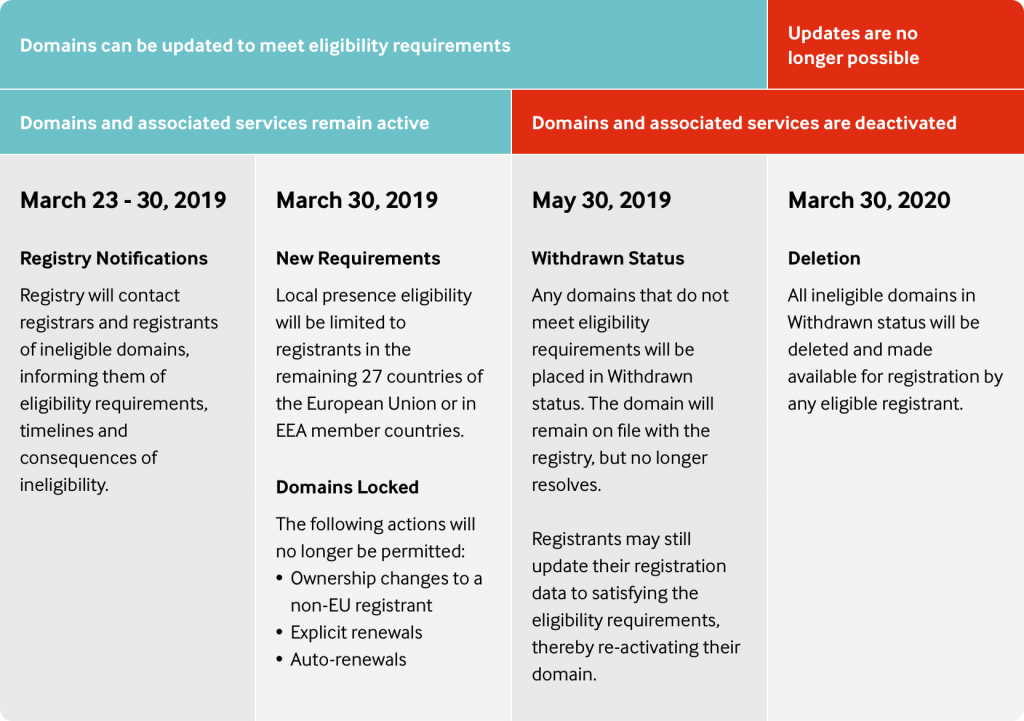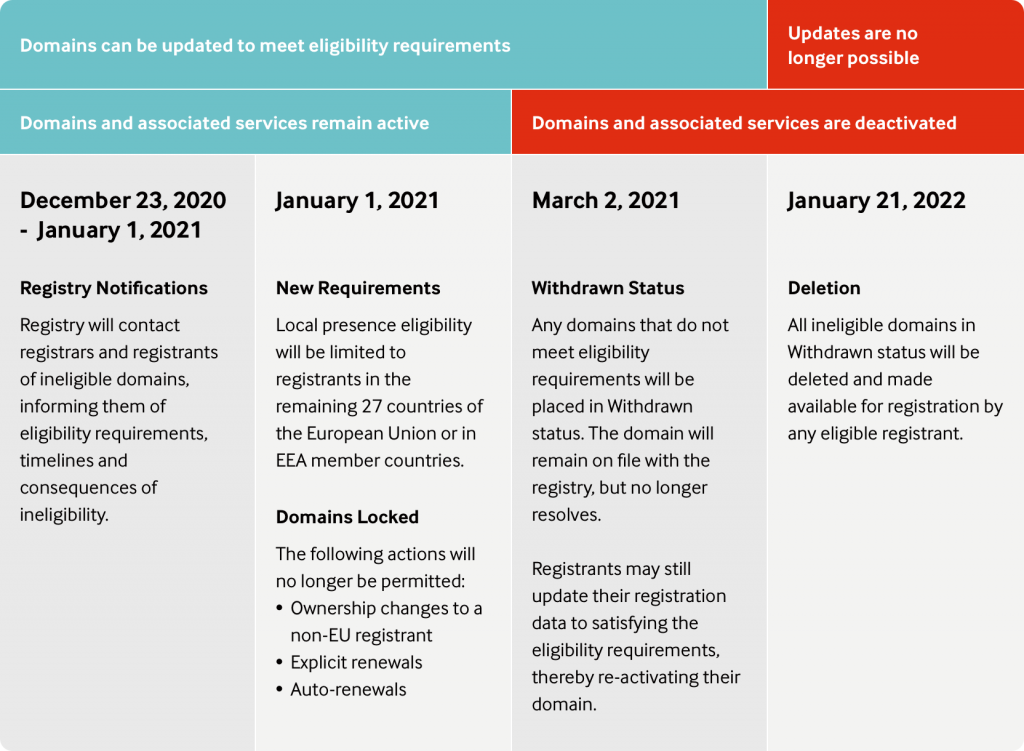If you own .EU domains and are a UK resident, you may already be aware of an announcement made by the European Commission last March on the future of .EU domains registered to UK organizations and individuals. In short, once the UK officially withdraws from the European Union, individuals with an address in the UK and Gibraltar, and UK companies without a presence elsewhere in the EU, will no longer meet the eligibility requirements.
Much to the disappointment of the domain community, the European Commission has decided against “grandfathering” the 300,000 .EU domains already registered with a GI or GB country code, an action which would have allowed existing owners to renew their domains indefinitely, despite the country code no longer being eligible. We would have appreciated a more creative solution than existing registrants simply losing their right to ownership. Regardless, it’s time to start preparing affected registrants for this change.
No one knows how Brexit will proceed, but in late January 2019, EURid, the .EU registry, released details on how it would approach this transition. There are three possible scenarios:
Below you’ll find what each of these three scenarios would mean for .EU registrants based in the .UK.
If the UK leaves the EU on March 30, 2019, without having reached a withdrawal agreement, here’s what will happen. You can also jump to the summary table below.
Starting at March 30, 2019, 00:00 CET (March 29, 2019, 19:00 EDT), EURid will immediately stop allowing new registrations of .EU domains using a GB (Great Britain) or GI (Gibraltar) country code. For existing domains, EURid will no longer allow registrant transfers to GB or GI residents.
In March 2019, EURid will contact existing registrants who have listed a postal address with a GB or GI country code, giving them “the possibility to demonstrate their compliance with the .eu regulatory framework by updating their contact data.” For organizations, this would involve indicating a legally established entity in one of the eligible EU27 or EEA Member States. For individuals, this would involve updating their residence to a physical address located in one of the EU27 or EEA Member States.
The registrant may also choose to transfer the domain name to an EU resident.
Between March 30, 2019, at 00:00 CET (March 29, 2019, 19:00 EDT / 21:00 GMT time), when registrants are officially notified, and May 30, 2019, at 00:00 CEST (May 29, 2019, at 18:00 EDT), the registry will lock the impacted domains to prevent the following actions:
During this two-month window, UK registrants who wish to keep their domain active must update their contact info to satisfy the eligibility requirements or transfer the domain to an EU resident.
On May 30, 2019, at 00:00 CEST (May 29, 2019, at 18:00 EDT), any registrant who has failed to demonstrate their eligibility will have their domain placed in Withdrawn status — the domain won’t resolve (and any linked services will become inactive), but the registration record will remain on file with the registry.  At this point, the registrant is still able to reactivate their domain by updating their registration data to satisfy the eligibility requirements, thereby removing the Withdrawn status.
On March 30, 2020, at 00:00 CET (March 29, 2020, 19:00 EDT), all ineligible domains in Withdrawn status will be deleted and made available for registration.
We know this is quite a lot to keep in mind, so here is a summary of the “hard Brexit” key dates and events:

There are, no doubt, many EU27 citizens who reside in the UK and own a .EU domain name. These registrants, though still EU citizens post-Brexit, would become ineligible on March 30, 2019, as the current EURid policy determines eligibility based on the physical address of the registrant.
However, the EU Commission has announced policy changes which would allow EU citizens based in the UK  to regain eligibility. The registrants would, therefore, lose their eligibility upon the UK’s withdrawal from the EU on March 30 2019, but would likely become eligible again once the new .EU regulatory framework comes into force later this year. Unfortunately, it’s not yet clear how long of a gap there will be between the UK’s withdrawal from the EU and the implementation of updated .EU policy.
If the UK were to leave the EU on or after 31st December 2020, following a planned transitional period, EURid’s plan would be similar to the “hard Brexit” plan, but with an extended timeline. Here’s what would happen (summary table below):
In December 2020, EURid will contact existing registrants who have listed a postal address have with a GB or GI country code, giving them “the possibility to demonstrate their compliance with the .eu regulatory framework by updating their contact data.” Once again, for organizations, this would involve indicating a legally established entity in one of the eligible EU27 or EEA Member States. For individuals, this would involve updating their residence to a physical address located in one of the EU27 or EEA Member States.
The registrant could also choose to transfer the domain name to an EU resident.
Between January 1, 2021, at 00:00 CET (December 31, 2020, at 18:00 EST), when registrants receive their final notice, and March 2, 2021, at 00:00 CET (March 1, 2021, at 18:00 EST)the registry will lock the impacted domains to prevent the following actions:
During this two-month window, registrants who wish to keep their domain active must update their contact info to satisfy the eligibility requirements or transfer the domain to an EU resident.
On March 2, 2021, at 00:00 CET (March 1, 2021, at 18:00 EST), any registrant who has failed to demonstrate their eligibility will have their domain placed in Withdrawn status — the domain won’t resolve (and any linked services will become inactive), but the registration record will remain on file with the registry. At this point, the registrant is still able to reactivate their domain by updating their registration data to satisfy the eligibility requirements, thereby removing the Withdrawn status.
On 1 January 2022, at 0:00 CET (December 31, 2021, at 18:00 EST), all ineligible domains in Withdrawn status will be deleted and made available for registration.
Here is a summary of the “soft Brexit” key dates and events:

As mentioned above, an updated .EU regulatory framework that will allow for .EU domains to be registered by EU citizens living in the UK will come into effect in 2019. Therefore, EU citizens living in GB or GI would NOT become ineligible as a result of a “soft Brexit.” Depending on how EURid implements the new policy directive from the EU Commission, EU citizens living outside of the EU could potentially be required to actively validate their eligibility in order to maintain their registration.
In the event of a “soft Brexit” where the deal includes provisions for .EU domains, EURid would forgo the transition plans outlined in the scenarios above and instead adopt whatever transition plan the provisions call for. Â
The OpenSRS team is exploring how best to approach this situation and find solutions to minimize the impact on registrants. If you sell .EU domains we strongly encourage you to sign up for our .EU-Brexit Updates, an email series we will use to share developments, recommendations for resellers, and information about our own action plan, including how resellers can identify domains in Withdrawn status via the Control Panel and API.
Have you already given this situation some thought? If you’d like to share your approach, ask questions about this change, or provide feedback, please get in touch.
In the meantime, we have a few recommendations for our affected reseller partners.
1. Consider restricting multi-year renewals and registrations for .EU domains.Â
This will help avoid situations where a UK customer pays a sizable renewal fee, only to lose their .EU domain a few months later.
2. Consider displaying a warning to registrants during the registration process
It’s important that before registering a .EU domain, your UK-based customers are made aware of the impending change to the domain’s eligibility requirements. We recommend displaying a warning to customers attempting to register a .EU domain using a GB or GI address.
3. Keep in mind that the registry could contact your customers as early as March 23, 2019.
We recommend preparing to contact your affected customers before March 23, 2019, so that, in the event of a hard Brexit, the notice from the registry doesn’t come as a surprise. Over the next couple of weeks, we’ll provide more information that will help to inform your communications.
3. Advise those registrants who can to update their information to meet the eligibility requirements as soon as possible.
This will ensure their domain(s) does not fall into Withdrawn status and become inactive.
Once again, if you sell .EU domains, we highly encourage you to subscribe to our .EU-Brexit Updates series to stay up-to-date as things develop.
Original source: www.enom.com/blog/
